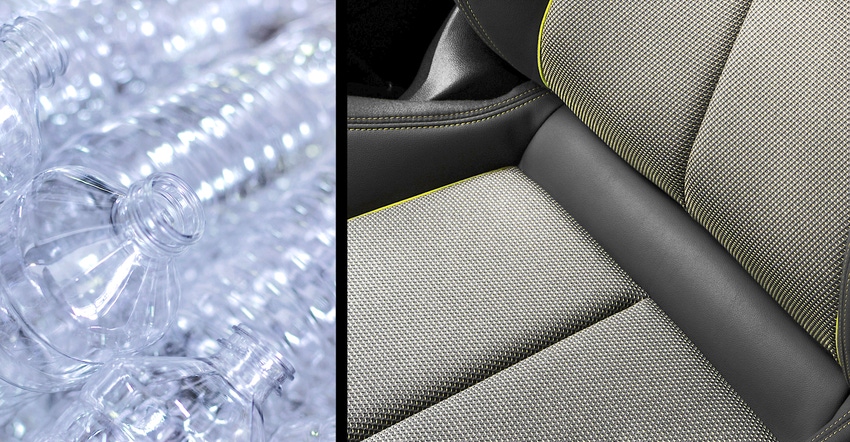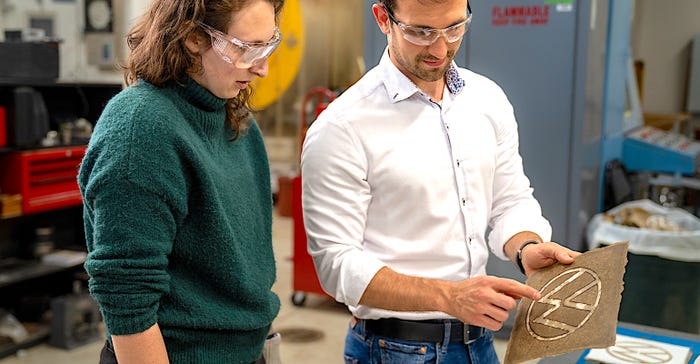How the Auto Industry Is Embracing Plastic Recycling
Turning post-consumer plastic products into new auto parts keeps plastic out of the waste stream.
August 4, 2023

The dual needs to reduce the consumption of new resources in creating plastic products and to reduce the eventual creation of plastic waste when products have been used drive the pursuit of recycled materials in the auto industry.
Plastics are pervasive in modern vehicles, creating the opportunity for significant reuse of plastic. We’ve seen this in the case of the Ford Bronco Sport, which employs recycled plastic from recovered fishing nets in its wiring harness clips. The aim is to expand use of the material into other applications such as engine covers. The ultimate potential is for as much as 700 lbs. of plastic per vehicle to be created from recycled materials, according to Ford technical expert Alper Kiziltas, with about 10 percent of that eligible to be made using the recycled fishing net material.
Reusing Wreckage
Some more visible applications of recycled plastics in new automotive parts are in the cars’ interiors, where consumers will see the materials during every drive. Audi has partnered with LyondellBasell, the world’s largest producer of polymer products, to produce plastic seat belt buckle covers for the Q8 e-tron EV using plastic recovered from parts of crashed Audis.
“As part of the PlasticLoop project, we are working with Audi to establish an innovative closed-loop process, recycling plastic automotive parts for use in new vehicles,” said Erik Licht, LyondellBasell Advanced Polymer Solutions New Business Development Director. “For the first time, we are using chemical recycling to recycle mixed automotive plastic waste into plastic granulate for automotive interior applications,” he said. “The plastic granulate is then used in the production of the seatbelt buckle covers for the Audi Q8 e-tron.”
“We want to use secondary material wherever it is technically possible, ecologically feasible, and of course, environmentally friendly,” said Philip Eder, project manager for circular economy procurement strategy at Audi. “Recycling is not that easy, because as you can imagine, if something is mixed up, it is not that easy to separate it again.”
PET Water Bottles
The polyethylene terephthalate (PET) plastic used in plastic bottles is a more homogenous source of post-consumer plastic that Audi is also using. The company uses that PET in combination with residual textiles, and fabric selvages recovered from manufacturing plants to create Kaskade, a new fabric material that provides the soft surface and three-dimensional texture of natural fiber materials such as wool.
Kaskade cannot be made from entirely recycled materials, but the company strives to maximize the recycled portion of the material mix, reports Christine Maier of Audi Design. “We used only as much new polyester and as many new resources as was technically necessary,” she said. “The result is a fabric that is reminiscent of wool and natural fibers, and has a very pleasant feel.”

The recovered selvage fabric comes from a plant making automotive products, so the material is already automotive-grade. Audi separates these into black and white components, using them to create an anthracite-colored blend that requires no additional dye. “We leave out another chemical process, which is better for the environment,” noted Maier.
Audi said that the company strives to procure well-sorted PET waste that is of high purity and then they process to avoid any minor impurities in the filament process. This could result in fiber inhomogeneity and potentially make the fabric unattractive. An advantage of using recycled PET is that it is abundant, which is an important consideration for an industry still bedeviled by supply headaches.
Finding the Right Mix
The selvage material, PET, and new polyester combine to create new yarn that is used to make the Kaskade seat cover fabric. The final product contains 15 percent selvage material, 35 percent PET, and 50 percent new polyester. “We performed a lot of tests to see how high the portion of selvages can be while ensuring the fabric still looks flawless,” Maier explained.
Audi started making seat covers using recycled materials for the fourth-generation A3. Those seat covers contain as much as 89 percent recycled material, using plastic from 45 1.5-liter PET plastic bottles. Then there are the additional 62 PET bottles that are recycled for the car’s carpet.
Ford Snares a New Source of Plastics in Recovered Fishing Nets
The carpeting and floor mats in the Audi e-tron GT are made of Econyl – a material that consists of 100 percent recycled nylon fibers from production waste, fabric and carpet scraps, or old fishing nets.
Audi acknowledges that one of the hurdles en route to a circular economy is that the cost of these recycled materials is higher than for virgin materials. Energy consumption in the process is about the same as for virgin materials, so efficiency is not an obstacle, according to the company.
Faurecia’s Seat for the Planet
Auto industry supplier Faurecia aims to use recycled materials throughout the entire seat and to make those same materials easier to separate at the seat’s end-of-life for future reuse and recycling. The company’s “Seat for the Planet” is a project that has created a lightweight seat that is about 15 percent lighter than a conventional seat.
It is made from ten modules each made entirely of a single material, made from bio-sourced or recycled materials, or from materials that are compatible for recycling, according to project manager Marthin Frétigné. Conventional seats are made using between 100 and 150 separate parts. The polyurethane used in seat cushions is especially challenging to replace with something earth-friendly. “This material performs well but is very difficult to recycle” said Frétigné. “So we had to replace it with a technical solution called Auraloop, incorporating high-performance PET combined with a new transformation process”.
Auraloop is Faurecia’s planned cushioning material that is made from a structure of recyclable polyester-based fibers. In addition to recyclability, Auraloop has the advantage of using half as much energy as polyurethane in its manufacturing process, according to the company, and they promise that it is even more comfortable and durable. It is made in partnership with Thai chemical company Indorama Ventures.
“Auraloop will replace those materials currently used in car seating with innovative and sustainable materials, based on polyester fibers, that offer a total recyclability of 100 percent,” pledged Nicolas Michot, Director of Technology at Faurecia Seating. The material should reach the market in two or three years, he said.
Volkswagen’s Paper Chase
In addition to recycling plastic materials, there is also the potential for the substitution of non-plastic components for automotive interiors. Volkswagen is currently experimenting with the idea of using recycled paper products as the source of reinforcing fibers in its plastics. Indeed, the Golf employs natural fibers in the map pocket on the car’s door panels.
The goal is to replace those natural fibers with the fibers recovered from recycled paper, reported Hendrik Mainka, who heads Volkswagen’s new Knoxville, Tenn. Innovation Hub. “The disadvantage of these [natural] materials is that even if they are already better, the natural fibers are grown in specific regions. Some come from India or Indonesia. You have a long logistics chain.”

Such long logistics might have been tolerable before the Covid pandemic, but now manufacturing companies want to keep their supply chains as short as possible. “The idea is to replace some of these natural fiber components with paper,” which is available everywhere.
Additionally, recycled paper is more consistent than natural fibers, he pointed out. “With paper, you are eliminating this factor because it is highly industrialized,” said Mainka. The cost of using recycled paper, however, is highly variable, depending on the location, so that is an area of research for VW. “We have a PhD student now working on the cost,” he said.
About the Author(s)
You May Also Like


